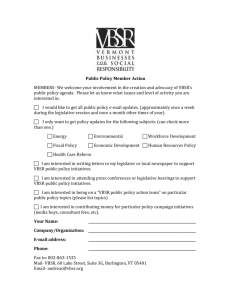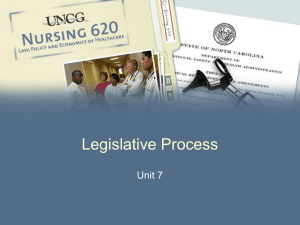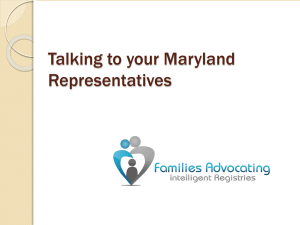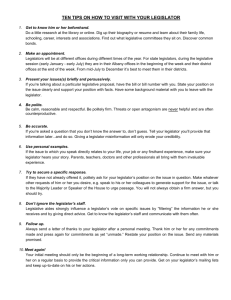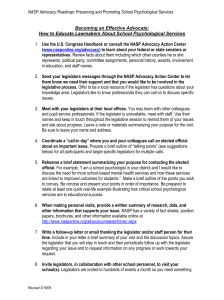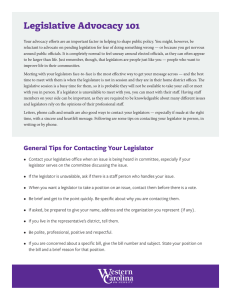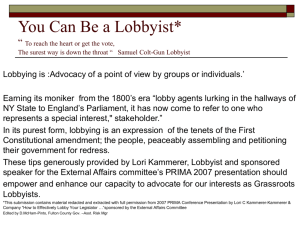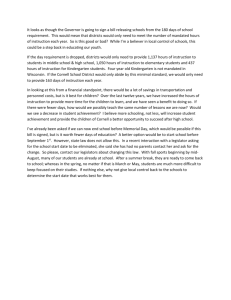Meeting A Legislator
advertisement
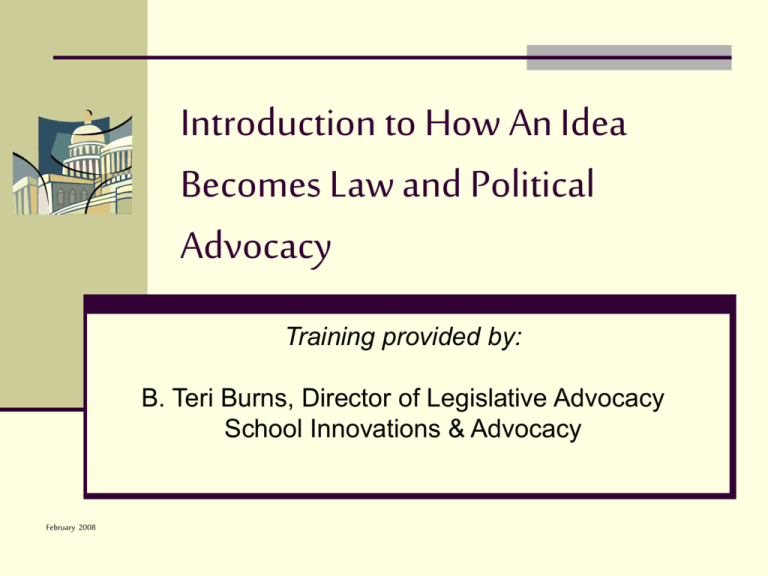
Introduction to How An Idea Becomes Law and Political Advocacy Training provided by: B. Teri Burns, Director of Legislative Advocacy School Innovations & Advocacy February 2008 The purpose of today’s training is to: Educate you on the legislative process. Explain how to appropriately contact legislators. Teach you how to effectively advocate. Instruct how to skillfully influence policy decisions. Organization of the State Legislature There are two chambers of the State Legislature: Assembly and Senate. (US Congress is also a two chamber system made up of the House of Representatives and the Senate.) Leadership Responsibilities Senate President pro Tempore Assembly Speaker Senate & Assembly Committee Chairs Other Education Players Superintendent of Public Instruction Office of the Secretary of Education State Board of Education California Department of Education Department of Finance Legislative Rules and Processes Two-year sessions: January-September (odd years; first year of session) January-August (even years; second year of session) Late January: Deadline for bills to Legislative Counsel Late February: Deadline to introduce bills Policy and fiscal committee deadlines Majority and 2/3rds vote Effective date of new laws Single subject Amendment rules Hearings in both houses Governor’s Veto and Veto Override Bill Enactment Process Bill Introduced Policy Committee Fiscal Committee Floor Repeat in Second House Governor Terminology Across the Desk Appropriation Caucus Coauthor Concurrence / Unfinished Business Daily File First, Second &Third Reading Reconsideration Spot Bill Suspense File Reading Legislative Documents Bills: Summary/Digest Sections Amendments Committee/Floor Analyses Bill Information: www.leginfo.ca.gov Language amended out Dates Amended House and Bill Number Author and Coauthor(s) Date Introduced Section(s) of Code(s) Affected & Subject of Bill (“relating clause”) Digest / Summary Anatomy of a Bill Language amended in Build a Relationship with Your Legislators Know your legislators and staff. Subscribe to the legislators’ newsletters. Understand the issues important to your legislators. Know what your legislators are looking for. Recognize them for efforts to help. Effective Letter Writing (Sample Letter) Date The Honorable __________________, Chair _____________________ Committee State Capitol, Room # Sacramento, CA 95814 Support (or Oppose): Bill Number and Author Dear Senator / Assembly Member__________: On behalf of the _______________ School District, I urge your support of bill number and author when it is heard in the __________________ Committee. This bill would…provide brief summary of the bill. Provide information on the effect this bill would have on your district program. Summarize your point and urge the legislator to support or oppose the bill. Please feel free to contact me at phone # if I can provide any additional assistance in this matter. Sincerely, cc: Members, _____________ Committee Author of the Bill Other Interested Parties *Be sure to check with your district administration before sending letters* Meeting A Legislator Create a one-page executive summary (a “leave-with” document) Start with conclusion Use easy-to-read charts Do your homework Understand opposing position Ask for advice Meeting A Legislator Strategize with your group about who will start the conversation. Introduce yourselves. Mention something that you have learned about the legislator’s background. Be as gracious to a legislative aide as you would be to a legislator. In light of term limits, the aide’s role is significant. Meeting A Legislator Be aware of all sides of the issue and look at the total educational picture when proposing action(s). Be prepared to respond to potential criticism and prepared to explain why your issue should be a high priority. Offer to be available to answer questions in the future. Invite them to your program anytime they are in the district. Be alert to cues regarding timing, apparent interest, level of understanding, etc. Thank them and offer to be a resource. Post-Meeting Follow-Up Communicate Share information with the your group Evaluate What was gained? What could have been improved? Plan your strategy for the next meeting. Send a thank you note to legislator/staff. What makes an effective advocate? Effective Advocates Are: Well informed regarding the subject and armed with information supporting their goals. Knowledgeable about the legislator’s constituency. Resourceful Quietly persistent Sincere What makes an effective advocate? Respectful of others’ points of view Politically aware Tactful Enthusiastic Timely Focused Helpful Legislative Links: Bill language and analyses: www.leginfo.ca.gov Information on Senate members and committee hearings: www.sen.ca.gov Information on Assembly members and committee hearings: www.assembly.ca.gov Thank you! The next step is up to YOU! Don’t be afraid to go talk to your elected representatives. They work for you.
